Sharlyn J. Lauby's Blog, page 56
March 20, 2022
Bring Back Regular Talent Conversations

Estimated reading time: 3 minutes
I saw an interesting article on Human Resource Executive online titled “2 big tasks coming to HR in the next decade”. It’s a good read that focuses on a couple of issues organizations are facing right now – the candidate and employee experience. As I was reading the article, it reminded me of a few things that organizations and HR departments need to remember as they’re thinking about creating a candidate and employee experience.
This article tended to focus on post-pandemic strategies. While I appreciate that, I also believe it’s time to realize that many of the candidate and employee experience challenges we are dealing with now are the same ones we were dealing with pre-pandemic. Don’t get me wrong, the pandemic has created change in our personal and professional lives. But not all the challenges we’re experiencing from a talent perspective are directly related to the pandemic. They’ve been brewing for a while. Maybe even a long while!
Back to the article. One of the points the article made was about the need to redesign work. I totally agree with this. I’ve written before about how HR professionals should consider themselves the architects of work and as such, they should always be making sure that the work fits the needs of the organization as well as the needs of the employee.
But the point I want to make here is that redesigning work isn’t a pandemic thing. Or even a post-pandemic thing. Organizations and HR departments should be regularly evaluating work and redesigning it as needs change. Redesigning work should be an ongoing thing and should be a regular conversation within workforce and staffing planning.
The second big takeaway from the article was that organizations need to understand and react to the market. Companies do this now in terms of what consumers want and they need to do it for what candidates and employees want. I like to think of this as the employee value proposition (EVP). It’s what an employee gets for working at a particular organization.
Does an organization have to pay the highest and offer the most benefits? No, they don’t. But they do need to put together the right mix of pay, benefits, learning opportunities, and workplace culture that will attract, engage, and retain employees.
Again, neither of these points are pandemic related. We were having these talent conversations before then. Or at least, we should have been having those conversations all along. It’s time to start having regular discussions in the organization about talent.
What kind of candidate experience do we want to offer?What’s our employee value proposition? How are we communicating it to candidates and employees?If candidates are turning down our offers, why? Is there something we can address?Is our EVP internally fair and externally competitive? If not, what can we do to make it that way?Do current employees know the EVP, like the EVP, and use components of the EVP? If not, are there changes we need to make?I’m not trying to minimize the pandemic. Many people have suffered, and lost people close to them. It’s not over yet and we still have much to do. But if organizations want to hire and retain the best employees – and I believe they do – then these should be regular talent conversations that happen in the organization. Not just pandemic conversations. They can’t be pushed off.
Talent conversations are just as important as conversations about business and strategy. Because it’s the organization’s talent that makes the business and strategy happen.
Image captured by Sharlyn Lauby while exploring the streets of Las Vegas, NV
The post Bring Back Regular Talent Conversations appeared first on hr bartender.





March 15, 2022
Different Industries Require Different Labor Law Postings #MindTheGap

Estimated reading time: 6 minutes
(Editor’s Note: Today’s article is brought to you by our friends at Poster Guard® Compliance Protection , a division of HRdirect and the leading labor law poster service that gets your business up to date with all required federal, state and local labor law postings, and then keeps it that way — for an entire year. Enjoy the article!)
I recently shared with you some history about the term “Mind the Gap” and how we can use it in a compliance context, especially when it comes to labor law posting requirements. We discussed the “3 Employee Groups with Unique Labor Law Posting Requirements” mentioning remote employees, job applicants, and Spanish language postings.
Today, let’s add another consideration we need to “Mind the Gap” about. Every organization isn’t the same when we’re talking about labor law postings. For instance, here are three industry specific labor law posting requirements that organizations need to know.
Industry Gap #1: All businesses are not the same. Different industries have different posting requirements.
Currently, there are six federal labor law posters that most businesses are required to post.
Equal Employment Opportunity Commission (EEOC)Occupational Safety and Health Administration (OSHA)Family and Medical Leave Act (FMLA) Uniformed Services Employment and Reemployment Rights Act (USERRA)Fair Labor Standards Act (FLSA)Employee Polygraph Protection Act (EPPA)Certain types of businesses have additional posting requirements. For example, regular HR Bartender readers know I have a hospitality industry background. I’ve known for years that some states require restaurants to post information about alcohol service, notices for tipped employees, and cardiopulmonary resuscitation (CPR) and choking assistance information.
However, I didn’t realize that health care organizations might have up to 15 additional notices covering areas such as biohazard materials, radiation areas, overtime rules, and Health Insurance Portability and Accountability Act (HIPAA) Notice of Privacy Practices.
Even when it comes to federal posting requirements, we cannot assume that all organizations are the same. Some public-sector organizations are required to post employee notices on whistleblower protections, right to know postings, and information about electronic monitoring. Government agencies also have their own unique versions of the OSHA and FLSA postings.
Industry Gap #2: If your organization has government contracts, don’t forget federal contractor postings.
According to the U.S. Treasury Data Lab, the United States government spent $6.82 trillion (and that’s not a typo) in 2021. While a big piece of government spending goes towards programs like Social Security and Medicaid, billions of dollars end up in private sector companies. And as you would expect, a big chunk of those billions go to defense contractors.
However, according to report from the Congressional Research Service, 23% of government contracts are targeted for small businesses. My point here is that we can’t make assumptions that only big businesses are federal contractors. Many different types of organizations have contracts with the government: financial institutions, technology companies, non-profits, auto dealers, retailers, service establishments, etc. If you’re a federal contractor, then you have additional posting obligations. Here is just a sampling of the most common federal contractor posters:
Davis-Bacon ActDepartment of Defense (DOD) Fraud HotlineDepartment of Homeland Security (DHS) HotlineDepartment of Transportation (DOT) Federal Highway Construction“EEO is the Law” SupplementE-Verify/Right to WorkMinimum WageNational Labor Relations Act (NLRA)Paid Sick LeavePay Transparency StatementWalsh-Healy Public/Service ContractsAnd I know it goes without saying, but I’ll say it anyway, the penalty for non-compliance isn’t just a fine. It could be losing your government contract. I’d like to think that, if your organization has a nice contract with the government, it’s worth your while to maintain compliance and keep the contract.
Industry Gap #3: Organizations that have their federal and state postings, but not their industry specific ones, are still at risk.
Speaking of fines, it might be tempting to think that the organization doesn’t need to spend a lot of time worrying about the “poster police” because the company can simply pay the fine and move on. Someone might say, “So, what’s the big deal if the company doesn’t have their industry postings?”
Let’s remember that the purpose of a labor law posting is to inform employees of their legal rights (and responsibilities) under federal, state, and local law.
Sad to say, but I’ve heard the chief financial officer of a company suggest not putting up posters because they were “ugly”. Thankfully, they came to their senses and realized they needed to focus on the purpose of the posting and their responsibilities as an employer.
The reason I wanted to mention the ugly poster comment is because I’m not naive. I realize that organizations might have plenty of money to pay a fine. The question becomes do companies want to pay two fines? Six fines? Ten fines? I spoke with Lillian Chavez, Esquire, compliance attorney for HRdirect, and she told me that the fines for a federal notice violation could be as much as $38,000+ per location. So, let’s say that you’re an auto dealer with 4 locations that services government vehicles. That puts your risk potential at more than $150,000. Not to mention the impact on liability in an employment lawsuit, and negative public relations if job candidates and employees found out.
Close the Labor Law Posting Compliance GapWhat amazes me about these posting requirements isn’t that labor law compliance is complex. Staying current with legislation is complex in general. The amazing part to me is that organizations don’t look for ways to make the process easier. In ComplyRight’s 2019 National Small Business Compliance Pulse Survey, 62% of small businesses rely on manual processes to manage these tasks.

It doesn’t have to be that way. Our friends at Poster Guard have a Labor Law Poster Service that will do it for you. Yes, that’s right. Poster Guard monitors labor law requirements (at the federal, state, and local level) and lets you know when things change. They also provide you with replacement posters every time there’s a mandatory change FREE of charge!
When I became a consultant, one of the first lessons I learned was that just because I could do something doesn’t mean I should. Spending huge amounts of time on manual tasks keeps me from my clients. The same applies to other businesses. Organizations spending lots of time manually tracking labor laws keeps them from their customers and employees. That has a direct impact on the bottom-line.
Now is a perfect time to make sure the organization closes their compliance gaps. Check out Poster Guard’s latest on-demand webinar on “Labor Law Compliance Requirements Employers Often Overlook”. It’s filled with reminders that all organizations need to stay compliant.
The post Different Industries Require Different Labor Law Postings #MindTheGap appeared first on hr bartender.





March 13, 2022
HR Competencies Change as the Business World Changes
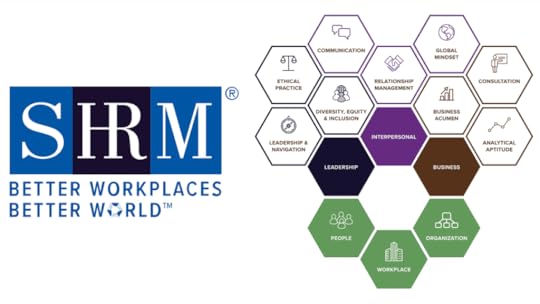
Estimated reading time: 8 minutes
We’ve been talking over the past couple of years about how the business world is changing. We’re seeing it all around us. Employees expect different things from their employer. New technologies are being introduced. It only makes sense that because business is changing that HR would change along with it.
If you’re not aware, the Society for Human Resource Management (SHRM), recently made some changes to their HR competency model as well as the SHRM-SCP and SHRM-CP exams. To give us an update, I spoke with Nancy Woolever, SHRM’s vice president of certification operations. I’ve known Nancy for a number of years and am so excited to have her here with us. She’s the author of “Ace Your SHRM Certification Exam: A Guide to Success on the SHRM-CP and SHRM-SCP Exams”, which just released a second edition.
Nancy, thanks so much for being here. Before we talk about the exam, let’s start with a conversation about competencies. Why do competencies need to be updated? And can you give us a brief overview about how the process of updating competencies happens?

[Woolever] Keeping up with the evolution in any profession is important so that credentialing exams, such as the SHRM-CP and the SHRM-SCP, represent a state-of-the-art definition of what constitutes the profession of human resources. SHRM conducts a comprehensive practice analysis every three to five years to ensure that the testing framework for both certification exams is not only accurate, but timely, and reflects input from HR professionals at all four career levels (from early career through executive level). SHRM also takes great care to involve HR professionals across the globe in its analyses to ensure the exams are truly universal.
The process of updating competencies begins with analyses of HR industry-specific research conducted since the previously completed practice analysis. This is so questions can be crafted to gain feedback from subject matter experts (SMEs) who participate in the current analysis about which content areas and behavioral competencies are important, and to what level an HR professional must be proficient in each to competently make decisions, solve problems, and guide the course of HR at their employer’s organization. Using multiple modalities to collect this data—for example, conducting focus groups first to inform discussions about how the HR profession evolves over time and then conducting a universal validation survey—enrich the content and the comprehensiveness of the practice analysis outcomes. This then translates to the test blueprint – the framework of what will be tested on the SHRM certification exams.
SHRM recently updated their HR competency model. We’ve written about the competency model before . Tell us what changed from the previous version.
[Woolever] For all intents and purposes, just as the profession evolves, so do the competencies required for proficient work in HR. Indeed, the lines between the standalone competency model and the SHRM Body of Applied Skills and Knowledge (BASK) exist in tandem. The model itself has become the SHRM BASK.
The biggest change will come as no surprise to HR professionals, especially in light of the continued emphasis in organizations and in society in response to, for example, social injustices and the continued need to build workplace cultures that include—rather than exclude or alienate—every individual and the unique qualities, skills, knowledge and attributes each brings with them to work. Consequently, diversity and inclusion emerged as a behavior HR professionals must demonstrate rather than something one simply ‘knows about.’ Diversity, Equity, and Inclusion consequently became the ninth behavioral competency that is part of the Leadership competency cluster in the SHRM BASK.

Two other behavioral competencies and two HR functional areas under the Technical Expertise Knowledge Competency also emerged with new names that better align with how HR is practiced:
Global and Cultural Effectiveness became Global Mindset Critical Evaluation became Analytical Aptitude HR in a Global Context became Managing a Global Workforce HR Strategic Planning became HR StrategySome of the content emerged as more important whereas some emerged as less important than in the previous practice analysis. However, the content overall changed very little, except for fleshing out the definitions of Diversity, Equity and Inclusion behavioral competency as borne out by the focus groups and survey research.
I assume that even though the HR competency model has been updated, if I’m currently certified, I’m still certified. But does this mean that the SHRM-CP and SHRM-SCP exams will change in the future? If so, how?
[Woolever] In terms of content, the SHRM BASK continues to define the test blueprint, meaning the content of the SHRM BASK drives the testing framework. This is no different than in the past so no changes there! What does change slightly are the ranges of items of each of the content areas that are tested on an exam form based on the importance level of content topics and proficiency indicators that define what competent performance ‘looks like’ in practice.
The major change in the exams is the evolution of DE&I from a technical to a behavioral competency and the consequent expansion of DE&I content to be both timely and in alignment with what occurs in practice today.
Speaking of certification, let’s talk recertification . One of the things that I try to do when thinking about my recertification is look for opportunities to challenge myself. For example, I try to earn professional development credits (PDCs) in each category versus just one area. If I want to challenge myself, are there any areas in the new SHRM BASK that I might want to focus on?
[Woolever] Reviewing the types of Professional Development Credits (PDCs) many SHRM-certified HR pros use to recertify, the vast majority earn most of their PDCs through Advance Your Education instructor-led or self-directed programs.
I always like to encourage folks who are learning lots of new things to leverage what they are learning to complete one of many ‘wish list’ projects on every HR professional’s desk! You can apply what you learned in a program to improve a process, policy, or program at your organization. Complete a 40-hour project for 10 PDCs, or an 80-hour project for 20 PDCs, or a 120-hour project for 30 PDCs. You can basically earn Advance Your Organization PDCs for completing things you do every day on the job to make changes at work. Not many people do this; it’s a definite opportunity!
We have also greatly expanded the options under the Advance Your Profession PDC category to include more projects, research, writing and editing options, but also volunteerism opportunities and membership in SHRM.
Volunteering or taking a national volunteer leadership role on the board or a chapter is not only a great way to give back to the profession, but also fills a critical need in the SHRM Chapter and State Council network. Many hands make light work – so why not investigate volunteerism projects as shown in the SHRM Certification Portal under the ‘Add PDCs’ feature. The list includes national, chapter and state council roles, participating on the A-Team (the Advocacy Team) and participating in Capitol Hill Visits, plus opportunities to volunteer for test-development roles too—working on writing and editing the content of future SHRM-CP and SHRM-SCP test items. Expand your PDC repertoire by checking out what all you can do under Advance Your Profession (AYP). The other category within AYP is presenting – either a session or a whole program or class.
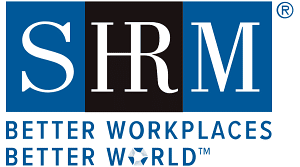
Last question. For individuals looking for more information about the new SHRM BASK and competency development, what are some resources that they can access?
[Woolever] Use the ecosystem of Preferred Providers – including SHRM, SHRM Chapters, SHRM State Councils and SHRM Academically-Aligned colleges and universities. In addition to the 3500+ recognized preferred providers themselves, any program offered by SHRM, an affiliate or a preferred provider must, by definition, align with one of the competencies in the SHRM BASK.
Many newly minted SHRM-certified HR professionals also use their official results report to assess where to target future professional development. Then, they look through the catalog and offerings by all providers to select professional development programs that align with a specific competency or competencies they have targeted for development. It’s possible to build a development road map by seeking out the information about which competency or competencies programs address through instruction.
I want to thank Nancy for giving us an update along with a list of valuable resources. If you want to learn more about certification, please check out SHRM’s certification webpage. It’s full of tools to help HR professionals stay current with competencies.
Personally, I’m very happy to hear that the SHRM competency model is reviewed and updated on a regular basis. It gives me a roadmap for my own professional development. And staying relevant is important if we want to have an impact in the organization.
The post HR Competencies Change as the Business World Changes appeared first on hr bartender.





March 10, 2022
How to Properly Plan a Reduction In Force

Estimated reading time: 4 minutes
By now, we’ve all seen the news story about the CEO who fired 900 employees via a Zoom call. He took a “leave of absence” for a few months. But the company is back in the news for another round of layoffs, this time they’re cutting about 3,000 jobs. I’m not looking to rehash these stories, but it did remind me that there are many factors that an organization needs to consider when making workforce decisions like this one. So, I wanted to share a few of them.
First of all, it’s important to understand that regardless of the reason a person is leaving your organization: resignation, firing, layoff, reduction in force (RIF), etc., they deserve to be treated with respect. The organization might not be happy the employee is choosing to leave. The employee might not like the company’s decision to end their employment. But that doesn’t mean a person deserves to be treated with disrespect. Remembering to treat departing employees with respect drives the rest of the process.
Secondly, if the organization is initiating this conversation, then they need to understand what action they’re taking. For example, a furlough is when the organization imposes a mandatory leave of absence or reduced work schedule. A layoff is when the employee is separated from the company, but there’s a reason to believe at some point in the future, the employee will be recalled (i.e., asked back). A reduction in force is when the employee is separated from the company with no intention of being recalled. How the employee’s departure is categorized can impact things like unemployment claims. It can also impact how an employee plans their next career move.
Third, get your employment attorney involved. This is definitely one of those moments when you do not want to figure that you can save a couple of dollars and not consult legal counsel. Your attorney can be a sounding board when making decisions about who will be impacted, the best way to communicate the decision, and the legalities associated with finalizing a person’s time with the organization. There are laws that could be involved like the Older Worker Benefit Protection Act (OWBPA) or the Worker Adjustment and Retraining Notification (WARN) Act. Plus, every state has unique laws about when final paychecks must be issued.
Also get your executive team involved. I have actually seen situations where the CEO communicated a layoff then told their executive team. Not good for many reasons. HR should play an integral role in the planning of this event. Accounting will need to know about final paychecks. IT will need to know about computer access. Marketing might want to monitor the organization’s brand channels. And operations still needs to get the work done. There’s one other topic the executive team should discuss and that’s how the organization plans to assist departing employees – severance, outplacement, etc. Not only is this good for the employees who are departing, but it’s good for the employees who are staying to see that their colleagues are getting treated with the respect they deserve.
Now, put together a communication plan. The organization need to decide who is going to communicate the message. The CEO is a logical choice. Sometimes the CEO keeps their message at a high level about changes that will happen then the employee’s manager and HR deliver the specifics. There should be conversations with people leaving the company and discussions with employees who are staying. This isn’t a “no news is good news” moment. Expect people to react emotionally. If managers haven’t ever received training on handling emotional situations, think about how to support them. And think about the employee reaction if a manager is departing.
Finally, plan some checkins with the current workforce. Employees are going to naturally wonder, “Am I next?” The organization needs to provide the appropriate assurances. Don’t say, “There will be no more layoffs.” if you don’t know that for sure. Be prepared to let employees vent and vent a little yourself. Then be prepared to move forward.
Planning any type of workforce reduction is stressful. This is just a high-level overview of what needs to happen. There are so many details. Organizations should get the right people involved, consider all of the options, and communicate to everyone. It’s not the employees’ fault that the organization is doing a layoff or reduction in force. The organization needs to remember that and plan their actions accordingly.
Image captured by Sharlyn Lauby at the SHRM Annual Conference in Las Vegas, NV
The post How to Properly Plan a Reduction In Force appeared first on hr bartender.





March 8, 2022
8 Recruiting Actions that Organizations Need To Be Effective
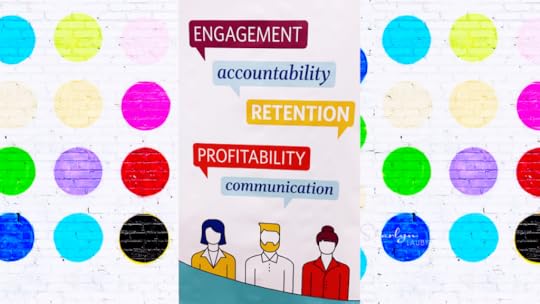
Estimated reading time: 4 minutes
Recruiting is top of mind in organizations right now. And it will remain that way for quite some time. The U.S. jobs report for February saw the biggest monthly gain since July 2021 and unemployment dropped to 3.8%. This means that recruiting functions need to work effectively and efficiently if they want to hire the best employees.
At last year’s Society for Human Resource Management (SHRM) Talent Conference, I listened to a panel of talent acquisition professionals talk about where they saw trends in recruiting. Here are my takeaways from their discussion, which are still very applicable today.
Make sure you know recruiting basics. Yes, there are a lot of new sources and technologies to help recruiters work faster and better. I’m not saying don’t try them. But those sources and technologies will be of greater assistance when you know the foundation. As part of understanding the basics, maybe it’s time to reevaluate recruiting procedures and eliminate outdated processes.Know the trends but don’t dismiss old school tactics. Similar to #1, there are some aspects of recruiting that remain effective – like networking. One of the speakers reminded us that “pick up the damn phone” still works as a recruiting strategy. As you’re putting together your plans to find talent, don’t forget some of those decade old tactics. They’re still effective. Have a compensation strategy. There’s a growing conversation right now about location-based pay. Organizations need to figure out their compensation strategy and be able to communicate it to candidates. In addition, if the company is doing sign-on or referral bonuses, they need to clearly understand the purpose of the program, be able to communicate it, and measure results. (P.S. Sign-on and referral bonuses should not be viewed as basic pay.) Understand the organization’s core competencies. Years ago, I worked for a company that had a handful of core competencies they wanted in every employee when recruiting. Examples included ethics, communication skills, etc. Then there were technical competencies related to the specific job. Organizations might find it helpful to identify the core competencies they want to see in every candidate. Refocus diversity hiring. The panel talked about how organizations have openly made commitments to improve diversity, equity, inclusion, and belonging (DEIB). They also pointed out that it’s time to move from talk to action. That action step might look different in each company, but it needs to happen . Talk about bias. Organizations need to discuss bias in terms of diversity and inclusion (#5). But organizations also need to talk about biases like candidates who wear jeans to interviews, have visible tattoos, and are sporting blue hair. These are just examples, but you get my point. Organizations are missing out on great employees just because they can’t get past a nose ring. Partner with marketing. One of the ideas I heard during the panel was to talk with marketing about having an employment branding specialist on their team. I love this and there are several advantages. Employment branding might not be a full-time responsibility right now so it allows organizations to dedicate a few resources (versus zero). It also could help ensure the consumer brand and employment brand are in alignment.Use data to tell stories. We can use technology tools to improve the recruiting process and to help us measure the effectiveness of our programs. Technology can help us gather data. And data tells a story. We need those stories. It helps improve processes and secure resources.I know this is a long list of to-do’s but it’s worth the time it takes to evaluate each one. Recruiting will continue to be a challenge. Organizations with sound processes will get more applicants. Companies that focus on knowledge, skills, abilities, and competencies will hire great employees. And recruiting departments that use data to partner with the rest of the organization will get the resources they need to do more.
Image captured by Sharlyn Lauby at the SHRM Talent Conference in Chicago, IL
The post 8 Recruiting Actions that Organizations Need To Be Effective appeared first on hr bartender.





March 6, 2022
Inclusion Happens When You Bring Your Authentic Self to Work [POLL]

Estimated reading time: 2 minutes
I’ve been thinking about inclusion lately. The Society for Human Resource Management (SHRM) defines inclusion “as the extent to which each person in an organization feels welcomed, respected, supported, and valued as a team member”. Inclusion can only exist if we feel comfortable being our authentic selves at work and if we accept others as their authentic selves.
But what I’ve been thinking about is how many people truly feel they can bring their authentic selves to work. Not just 10% of the time or even 65% of the time. But really bring it every day. In all your working relationships. I’m not suggesting that it’s easy. In this article from Harvard Business Review titled “How Much of Your Authentic Self Should You Really Bring to Work?”, they talk about it being a practice. Meaning that bringing out authentic selves at work isn’t just about others allowing it. It’s also about us being comfortable doing it.
So, I was wondering if you would answer a one question survey for me. Please note: this is a completely anonymous survey related to inclusion. No one – including me – can track responses.
Thank you in advance for answering this poll. Please feel free to share this with your social channels and point out that it’s anonymous. As always, I will post the results in a couple of weeks.
Organizations should be interested in the results of this poll. If they’re trying to hire people right now, those candidates will be looking for an employer where they can bring their authentic selves to work.
And if I’m an employee or candidate right now, this could be a moment of self-reflection. Can I honestly bring the real me to work? If I can, great! Inclusion may be able to happen! If I can’t…do I need to ask myself “Why not?”.
Image captured by Sharlyn Lauby while exploring the streets of New Orleans, LA
The post Inclusion Happens When You Bring Your Authentic Self to Work [POLL] appeared first on hr bartender.





March 3, 2022
Dynamic Teams Create Organizational Agility
Estimated reading time: 3 minutes
One of the biggest business lessons we’ve learned in the past couple of years is that agility is beneficial for success. Agility is more than simply being flexible. Don’t get me wrong – flexibility is important. I like to think of flexibility in terms of being able to address last minute changes or adjustments. It might be a situation that we knew was within the realm of possibilities, but we just didn’t think it would happen or happen at this particular time.
Agility is about being able to address something completely unexpected. The situation isn’t something we thought could possibly happen, so we probably didn’t even have a Plan B for it.
Another way to look at it is flexibility is about being good at change and agility is being great at it.
At the last SAP SuccessFactors conference, multiple speakers talked about agility being key to organizational success. They suggested that organizations can get better at agility by having stronger teams. Totally makes sense. Sometimes the reason that we’re not very good at agility on an individual level is because we don’t have any support. I might be really good at being flexible all on my own, but agility is hard without a team.
This means that organizations need to spend some time and resources on team dynamics.
Team dynamics refers to the behavioral relationships in the group. The focus of team dynamics is making sure the team feels a connection to each other. When team dynamics are good, then team communications happen at a high level. And the group knows how to recognize their successes and resolve their own conflicts. I like to think of team dynamics as the description of the group vibe. For example, is the group “fun” or “serious” or “filled with drama”?
When team dynamics are positive, the group is positioned to become a dynamic team.
Dynamic teams are focused on trust and collaboration. The team gets things done because they spend more time working together on a common goal (some might call it a BHAG). Versus spending time dealing with team dynamics. Positive dynamic team environments create engagement and better productivity. It could be said that dynamic teams are high-performing teams. They have the right team dynamics, and they know how to make things happen.
Organizations that want to create dynamic teams need to think about team dynamics.
This doesn’t mean that everyone on a team should be exactly the same. In fact, quite to the contrary. Dynamic teams need diversity. Should differences arise, the team needs to know how to work through those differences together. It will make them a stronger team.
As we think about the weeks and months ahead, organizations will want to focus on getting things done. Whether that’s in the office or remotely or some combination of the two. Teams will be important. And the team will not have the luxury of just waiting until everyone is together in the office to work on a project. Teams will have to be able to adjust quickly to the environment they are faced with. Thankfully, technology will be able to facilitate these transitions.
But it does mean that technology will play a role in team dynamics. Organizational learning departments will need to think about how employees can build positive working relationships using technology tools. Luckily, we’ve had some exposure to this over the past couple of years. Now is a great time to think about what’s been working well and what technologies will provide value in the future.
Image captured by Sharlyn Lauby at the SAP SuccessFactors Conference in London, England
The post Dynamic Teams Create Organizational Agility appeared first on hr bartender.





March 1, 2022
3 Employee Groups with Unique Labor Law Posting Requirements #MindTheGap

Estimated reading time: 5 minutes
(Editor’s Note: Today’s article is brought to you by our friends at Poster Guard® Compliance Protection , a division of HRdirect and the leading labor law poster service that gets your business up to date with all required federal, state and local labor law postings, and then keeps it that way — for an entire year. Enjoy the article!)
First introduced in the 1960’s on the London Underground, “Mind the Gap” is a warning phrase used to advise passengers to take caution when crossing the spatial gap between a train door and station platform. Its purpose is to remind us to maintain safety in an area where we probably already feel very comfortable.
We can use this “Mind the Gap” message when it comes to compliance. It’s very easy to dismiss warnings about compliance matters, like labor law posters, with “Oh, we have all the right ones.” or “There will be headlines everywhere when posters need to be updated.”. Not true. I’m not saying that the government is out to catch organizations that aren’t in compliance. But in today’s “signal and noise” world, it’s important to realize that there’s no guarantee that labor law poster updates are going to magically appear in the trending topics section of your favorite social media platform.
So, let’s talk about how labor law posters have some unique requirements for certain employee groups and what HR can do to stay in compliance (aka “Mind the Gap”).
Mind the Gap #1: Labor law postings are required for onsite and remote work environments.
According to Gallup, 45% of full-time U.S. employees worked from home either all or part of the time in the last quarter of 2021. While that’s probably going to change over the course of this year, it’s probably not going back to pre-pandemic percentages.
Remote work is popular for several reasons. It reduces the costs for commercial office space, decreases the carbon footprint, and makes employees more productive. A study from independent research firm Omdia reported that 68% of organizations believe employee productivity has improved with remote work.
Organizations with remote employees should audit their processes to ensure everyone has access to labor law postings. Some recent U.S. Department of Labor publications and court cases have confirmed that postings are mandatory for remote workers and electronic delivery is an acceptable alternative for meeting posting requirements for these offsite workers.
Mind the Gap #2: Labor law postings are required for applicants and employees.
We tend to think of labor law postings as being just for our employees. Truth is, four of the six mandatory federal postings apply to applicants as well. There are also state and local requirements. Physical postings must be displayed for applicants who come into your office for pre-employment interviews, testing, or any part of the application process. By law, most employers have to provide applicants access to these four federal postings:
Equal Employment Opportunity Commission (EEOC)Family and Medical Leave Act (FMLA)Employee Polygraph Protection Act (EPPA)Uniformed Services Employment and Reemployment Rights Act (also known as USERRA and recommended as a best practice because the law applies to applicants)In addition, if your organization accepts online applications, there needs to be a way for applicants to view them there too. Over 98% of Fortune 500 companies use an applicant tracking system (ATS) and with the continued focus on recruitment, it only makes business sense to automate the hiring process. As organizations continue to focus on recruitment, they will look to technology to help them automate their processes. This will mean thinking about compliance.
Mind the Gap #3: Spanish language labor law postings may be required regardless of the composition of the workforce.
The 2020 U.S. Census reports that the Hispanic population of the United States was 62.1 million, making people of Hispanic origin the nation’s largest ethnic or racial minority. Twenty (20) states and territories are required by law to have certain labor law postings in English and Spanish, regardless of the composition of the workforce. Additional federal, state, and local laws apply if you have locations with a certain number of employees who are not proficient in English. Some laws require foreign language translations of workplace posters for an individual employee, and others apply only if there’s a significant number of employees impacted.
Organizations can’t make the assumption that, if they do not have Spanish-speaking workers, they don’t need Spanish language posters. They also can’t assume if they have bilingual employees that they don’t need Spanish language labor law postings just because those employees also speak English.
Mind Your Labor Law Posting Compliance GapMost employers know they need to have labor law postings. That being said, I can also see organizations forgetting to “mind the labor law posting gap” and not taking the extra caution necessary with applicants, Spanish language postings, and remote workers.

The good news is that organizations don’t have to spend hours researching this information. Our friends at Poster Guard have a Labor Law Poster Service that will do it for you. Yes, that’s right. Poster Guard monitors labor law requirements (at the federal, state, and local level) and lets you know when things change. They also provide you with replacement posters every time there’s a change – FREE of charge!
Frankly, this type of service is a no brainer for me. As a HR professional, I have so many other things I need to spend my time on than researching labor law posters. Personally, I would much rather have a professional service do what they do best, which frees up my time to recruit, engage, and retain the best employees.
If you want to learn more about “Labor Law Compliance Requirements Employers Often Overlook”, check out Poster Guard’s latest on-demand webinar on the subject. It’s filled with reminders that all organizations need to stay compliant.
The post 3 Employee Groups with Unique Labor Law Posting Requirements #MindTheGap appeared first on hr bartender.





February 27, 2022
Right Now Effective Leadership Recognizes the Connection Between People and Profits

Estimated reading time: 6 minutes
The Society for Human Resource Management (SHRM) recently released a State of the Workplace Study that had some interesting findings. It reported that only 25% of HR professionals felt their organization was effective in finding and recruiting talent. And only 26% said that the organization was successful in developing people managers. What’s particularly challenging is that we all know there’s a relationship between management and recruiting.
While I was reading the SHRM Study, I also had on my desk “Simple Truths of Leadership: 52 Ways to Be a Servant Leader and Build Trust” by Ken Blanchard and Randy Conley. You might remember that I interviewed Dr. Blanchard a few years ago about leadership and management. Reading both the SHRM Study and “Simple Truths” at the same time made me realize that I should take the connection one step further. There’s a connection between management, leadership, and recruiting.
So, I reached out to Dr. Blanchard and asked if he would share his thoughts with us again. This time, I wanted to specifically focus on some of the challenges that organizations are facing right now in terms of management and recruiting. Thankfully, he said yes.
Dr. Blanchard, welcome back to HR Bartender! And congrats to you and Randy on your new book. For those who might be unfamiliar with servant leadership, how would you describe the concept?
[Blanchard] When people hear the phrase servant leadership, they are often confused. They think you can’t lead and serve at the same time. Yet you can if you understand that there are two parts to servant leadership:
A visionary/direction, or strategic, role—the leadership aspect of servant leadership.An implementation, or operational, role—the servant aspect of servant leadership.All good leadership starts with a visionary role. The traditional hierarchical pyramid is effective for this, the leadership aspect of servant leadership. While leaders should involve experienced people in shaping direction, the ultimate responsibility remains with the leaders themselves and cannot be delegated to others.
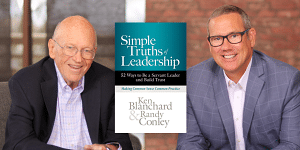
Once people are clear on where they are going, the leader’s role shifts to a service mindset for the task of implementation—the servant aspect of servant leadership. Here, servant leaders philosophically turn the traditional hierarchical pyramid upside down. When that happens, the customer contact people and the customers are at the top of the organization, and the ‘top’ management is at the bottom. Servant leaders now work for their people to develop them and help them win—accomplish their goals and the goals of the organization. Servant leadership is about developing great relationships, getting great results, and delighting your customers.
Speaking of customers, in your book, Simple Truth #11 says, “Profit is the applause you get for creating a motivating environment for your people so they will take good care of your customers.” How can servant leadership help people understand the connection between people and profit?
[Blanchard] Servant leaders know financial success is a byproduct of how their people and their customers are treated. If you serve and take care of your people as your most important customer, they will go out of their way to serve and take care of your second most important customer—the folks who buy your products and services. These people will become raving fans and tell their friends about the service they received, which serves the bottom line and the needs of the owners or shareholders. Organizations can’t survive without the loyalty and commitment of their customers.
One of the other things that I found interesting about Simple Truth #11 was the mention of creating a “motivating” environment. How does “motivating” differ from “engaging”? Which is preferred today and why?
[Blanchard] When you catch people doing things right and praise them, and when you give them a kind redirection instead of a reprimand when they go off track, they will feel engaged and then be motivated to continue doing their best. Engagement is a feeling of belonging, a desire to do your best work. Motivation is the willpower to act. I think both are necessary. You can’t really have one without the other.
One of the challenges that business leaders are facing right now is a staffing shortage. How can embracing servant leadership help organizations with their staffing challenges?
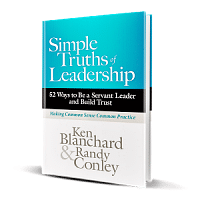
[Blanchard] These days it’s a buyer’s market when it comes to employment—there are more jobs available than there are people to do the work. If an employer with a servant leadership culture has an opportunity to talk with a prospective employee about the benefits of that culture—empowerment, support, direction, side-by-side leadership, trust—that person will have reason to lean toward that opportunity. If all other things are equal, a servant leadership culture will win over a hardline, top-down hierarchical culture every time.
I do wonder if one of the reasons that organizations might be struggling is because they have managers who are burned out and overwhelmed. What would you suggest to help those managers?
[Blanchard] People who supervise others at any level need training in what signs to look for when they suspect someone is burned out. HR departments should ensure people in the organization are aware of employee assistance programs (EAPs) that provide free counseling and other help for employees under stress. Resources are out there—it’s up to leaders in organizations to let people know what resources are available to them.
Last question, if managers only have time to focus on one thing in the upcoming year, what should it be? Why?
[Blanchard] Focus on your people. Pay attention to their needs. Listen to them and read between the lines. This is a difficult time for everyone, and you want to be sure you are the best employer they can imagine so they won’t want to join ‘The Great Resignation’. Treat your people right and they’ll treat your customers right and everyone will win.
My thanks to Dr. Blanchard for joining us again. If you want to learn more about servant leadership, check out his new book “Simple Truths of Leadership”. The book has 52 truths, one for every week of the year. I think it could be a practical, easy to use reminder for managers.
I believe Dr. Blanchard was right when he talks about the organizations that will attract and hire the best talent. It will be the ones with the best managers and leaders. Organizations have to give managers the support and resources they need to be successful.
Image capture by Sharlyn Lauby while exploring the streets of Fort Lauderdale, FL
The post Right Now Effective Leadership Recognizes the Connection Between People and Profits appeared first on hr bartender.





February 24, 2022
Define and Plan Your Job Transition – Ask #HR Bartender

Estimated reading time: 4 minutes
We’ve spent a lot of time talking about the challenging recruitment market right now, but today’s reader note reminded me of another tough aspect in recruitment – job transition.
What advice would you give someone trying to transition to an HR role that focus on business culture creation and talent acquisition to match said culture?
I think this is a great question because it touches on several different aspects of a job transition – the job, the company, the culture, and most importantly, your individual needs and wants. Let’s talk about each.
What job are you looking for? First, let’s talk about the work. Not the pay, but the work. You have to decide what you want to do. There could be many things you’re interested in and many things you’re good at. Bottom-line: What do you want to do? Whatever it is, you must be happy with it because you will be doing it all day. For example, in the reader note, they mention an HR role. Is that a generalist or specialist? And if it’s a specialist, what area of specialization – recruiting, compensation, employee relations, etc.? These are the types of questions you need to answer for yourself.
What employee value proposition (EVP) do you need? And want? Now that you’ve identified the work, you can think about what you’d like in terms of pay, benefits, and working conditions. As tempting as it might be to say, “I want it all.”, it could be helpful to define what “it all” means. What’s the minimum pay you’re willing to accept? What are the “must-have” benefits you need? In addition, think about what a company might offer that’s not on your must-have list, but it would be great if it were included. For instance, do you want to ask for authorization to attend a national HR conference? It’s not a deal-breaker, but it would be great. Or maybe that the company would pay for you to get your HR professional certification.
What type of company do you want to work for? In the reader note, there’s no mention of the industry. Granted, some positions might be industry specific. For example, if I’m a pilot, then chances are that I’m working in the transportation industry. Not always, but you get my point. As an HR pro, there are many different industries you can work in. If the work you’re looking for exists in multiple industries, then decide what type of industry would be best for you. Every industry has unique advantages and disadvantages. And if you’re thinking about trying out a new industry, maybe find someone who works in that industry and ask for the inside scoop.
What type of culture do you want to work in? Now that you know what type of company you want to work at, consider the culture. Culture is defined as the “attitudes and behaviors” of the organization. Once you identify the work you want to do and what industry you want to work in, then you can look at the companies in that industry to research which ones have the culture you’re looking for. I do believe it could be more difficult to do this the other way around – meaning identifying a company and then trying to figure out what you would do there in terms of work.
What are you willing to compromise on? What aren’t you willing to compromise? This ties into the last question about culture. If culture is about attitudes and behaviors, it’s important to identify the must-have attitudes and behaviors you’re looking for. And I hate to say it, but identifying culture isn’t about looking at the mission, vision, and values of the organization. While that’s good, it’s about seeing attitudes and behaviors in action. What behaviors do you “have” to see to know this is the right culture for you?
One of the biggest job search mistakes that I see people make is they don’t define what they’re looking for. They settle for “it needs to suck less than my current job”. That’s not the best job transition strategy (but you knew that). Take some time to clearly define your needs and wants so you can plan the transition that’s best for you.
Images from a Banksy exhibit captured by Sharlyn Lauby while exploring the streets of Atlanta, GA
The post Define and Plan Your Job Transition – Ask #HR Bartender appeared first on hr bartender.





Sharlyn J. Lauby's Blog
- Sharlyn J. Lauby's profile
- 10 followers



